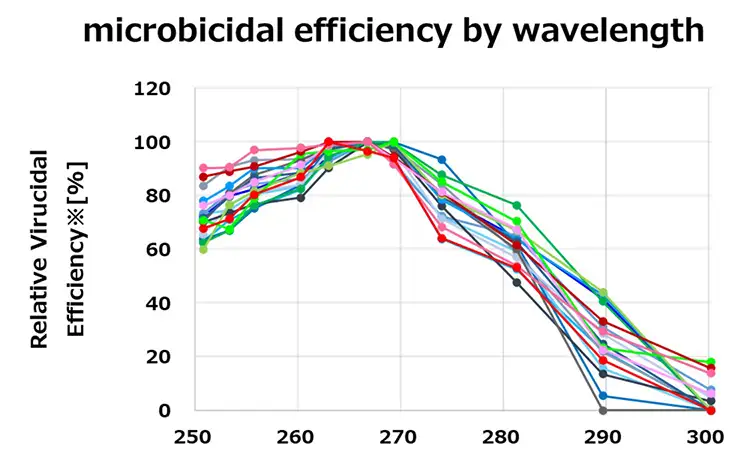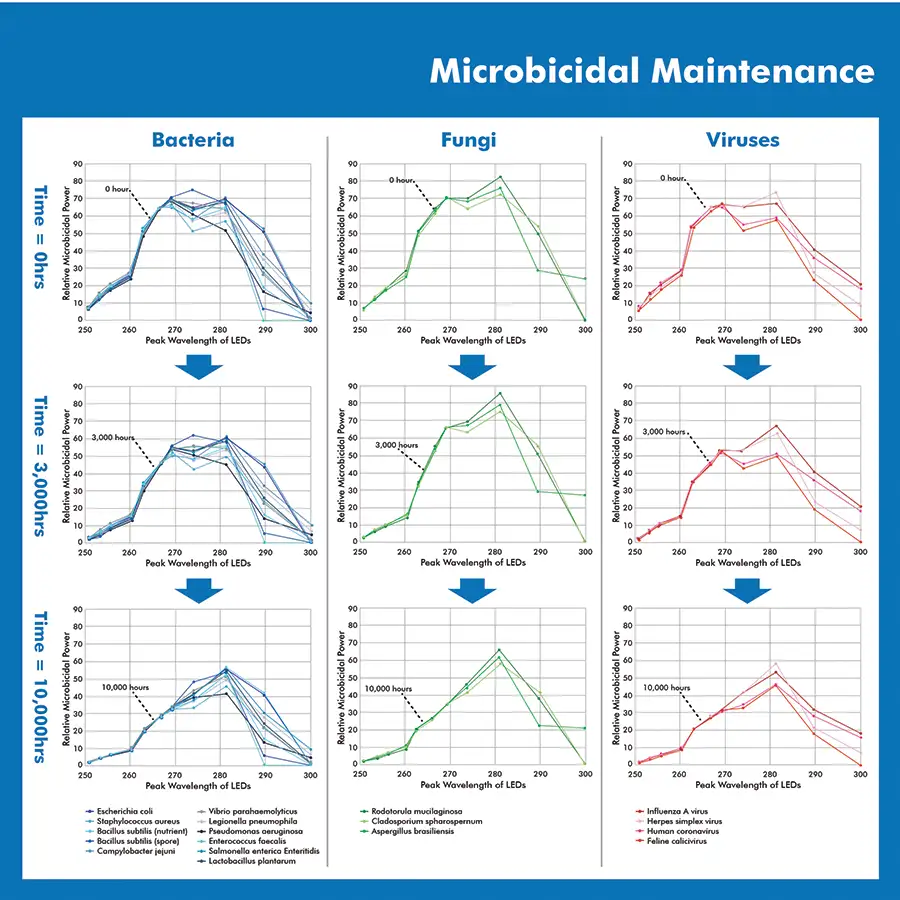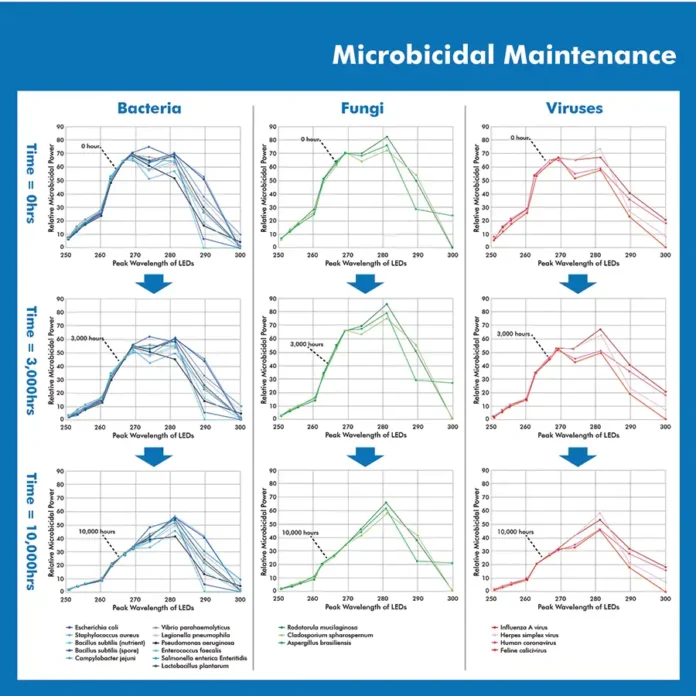By Shigeharu Yamauchi and Todd Mikowski, Nichia Corporation
Many have heard the fable of the tortoise and the hare. Despite big claims and confidence in his ability, the hare loses the race to the tortoise’s consistency. In a world of buzz words and SEO terms like “industry-leading” and “world’s most efficient,” it is easy to believe the claims (aka the hare). The UV LED industry is no different, often focusing on flashy claims rather than on the consistency of the device. This is a concerning issue as belief in the claims that fall short will lead to an inevitable black eye to the UV LED industry. Every company caters its message to its story. Combine this marketing-over-data approach with a lack of understanding and regulation, and the industry is left with misguided sales pitches that create a chasm of mistrust in a technology that has the potential to modernize the UV market. So where does the industry go from here?
Defining Key Characteristics
First, there is a need to define the key characteristics of a UV-C LED within a set application. The authors would argue the most important characteristics are radiant power, lifetime/reliability, wavelength, efficiency and cost. Each of these variables interacts with the others, contributing critical elements to a design. It is great to have the exact peak wavelength that most effectively inactivates a target pathogen, but if the design lacks the radiant power output, then the system will be forced to increase exposure time, thus changing the use case and end design of the product. Continuing that line of thought, if the output power and peak wavelength are sufficient, but the design lacks the necessary lifetime, then the system must be overdesigned or risk short service life. As in all things, the key is balance.
Radiant power and wavelength are well understood, and the scientific community is making great strides in updating or creating new inactivation curves to aid in the successful disinfection of target pathogens. The design variable most misunderstood or generally underappreciated is lifetime/reliability. Ultimately, the commercial deployment of UV-C LEDs will depend on the successful deployment of technology by LED manufacturers that effectively inactivates a pathogen and continues to do so over a competitive lifetime when compared to traditional mercury lamps. This ability to deliver radiant energy over time is what the authors’ company calls “microbicidal maintenance.”
Microbicidal maintenance is the percentage of maintained microbicidal power (microbicidal power = optical output x microbicidal efficiency) at time T.
To benchmark commercially available LEDs, the authors’ company tested three prominent UV-C LEDs with wavelengths from 265 nm to 275 nm. All the LEDs in this test claimed 10 K hours before reaching 70% of initial output. All lifetime tests were completed at moderate drive conditions (350 mA @ 25° C ambient temperature) to ensure an apples-to-apples comparison. The results showed all three of these LEDs fell short of the 10 K hr/70% output mark, with some reaching 70% as early as 1,000 hours and others making it to 4,000 hours. This is why it is so important to ask for the manufacturer’s test data – or, better yet, do in-situ testing of the devices.
This large variance in reliability should be a strong call to action for any designer seeking to develop a UV-C LED system: Go beyond the manufacturer’s claims. Designers should push their potential LED suppliers to provide the actual test data and conditions of the test. Internal testing of UV-C LEDs with trending of data every 500 to 1,000 hours also can be a powerful tool to confirm claims. Testing has shown even LEDs that look strong at 2,000 to 3,000 hours can degrade quickly. As the rate of degradation is different from LED to LED and wavelength to wavelength, this is why mathematical projections like TM-21 may not be well suited to UV-C LEDs broadly.
To successfully cross the chasm with UV-C LEDs, two things need to be accomplished: First, create microbicidal effectiveness curves for target pathogens; and second, create an understanding of how microbicidal maintenance can be applied to ensure UV LED systems meet safe end-of-life parameters for their applications.
Microbicidal effectiveness curves
Defining microbicidal effectiveness curves is in process, and the scientific community is making great strides to update old studies and to produce new ones. To aid in this article’s explanation, Figure 1 shows microbicidal efficiency data for 18 different pathogens at 13 different wavelengths. The research and data collection were conducted at Tokushima University in collaboration with Nichia Corporation’s new UV LED sensitivity evaluation device. With this device, researchers were able to determine the microbicidal sensitivity while ensuring the fluence rate and irradiance uniformity were equal for each wavelength. Figure 1 shows a clear peak of microbicidal efficiency around 268 nm to 270 nm.
Microbicidal maintenance
However, as stated before, this is only part of the story. Figure 2 shows microbicidal power (optical power x microbicidal efficiency) of the same 13 UV LED wavelengths for the 18 pathogens at times of 0, 3,000 and 10,000 hours. This is where the creation of understanding around microbicidal maintenance becomes crucial.

In all pathogen catagories (bacteria, fungi and viruses), there is high relative microbicidal power in the 265 to 275 nm range. This is logical since Figure 1 showed the peak effectiveness range was ~268 to 272 nm. However, even after 3,000 hours, the advantages at these wavelengths begin to collapse and, by 10,000 hours, their effectiveness is cut nearly in half. If a system manufacturer was to believe without verification the claims and initial optical measurements from a manufacturer, this could lead to designers adding more LEDs to make up for the reduction in effectiveness (best case scenario). In the worst case scenario, an unsafe system will not achieve the claims established by the manufacturer. The industry cannot accept the latter and must design with end-of-life conditions in mind.

Moving Ahead to Ensure Safety
Though data analysis and verification of data may be the necessary path today to ensure safety, it limits adoption, as testing inherently lags the rapid technological gains coming from the UV-C LED manufacturers. Many organizations are making great strides in characterizing LEDs and pushing toward standardized testing, but a definite solution has not yet been reached. LM-80 has been the long-standing set of test criteria within many visible LED applications (i.e. general illumination and automotive). Though it may not be perfect, it could provide a baseline and should be considered as a potential candidate to speed adoption. Because LM-80 inherently is only a framework for data, there is little risk it can be manipulated, leading to falsified claims.
However, as mentioned earlier, TM-21 – a method for lifetime maintenance extrapolation based on LM-80 test data – must not be used with UV-C LEDs. As wavelength characteristics dramatically impact lifetime from LED to LED, a one-size-fits-all mathematical extrapolation cannot yet fit as it previously did for visible LEDs. The breakdown is not consistent, as it is in visible LEDs. Within the rules of TM-21, claims can be manipulated based on the data set used. Additionally, the breakdown in UV LEDs is much more dramatic than that of visible LEDs. In white LEDs, degradation of, say 10%, generally occurs slowly over tens of thousands of hours. In UV LEDs, this can occur within thousands of hours, if not hundreds of hours. A TM-21 prediction easily could show strong radiant maintenance through 7,000 hours and mathematically show a 10,000- to 15,000-hour life, but then have a rapid breakdown at 8,000 hours. This breakdown would not be captured in the extrapolation, and claims could be made with the 7,000-hour data. For these reasons, extrapolation of life cannot be accepted, at least until the technology harmonizes and shows a consistent degradation curve.
There is no application where gas-arc technology has won out over solid-state lighting (SSL). UV-C technology will be no different. However, to see UV LED fully replace mercury lamps, the UV industry must learn from prior SSL adoption and avoid misguided claims made in the early days of other markets, such as general illumination and automotive. Not all LEDs are created equal; application, conditions and test results should drive LED selection.
Shigeharu Yamauchi, manager, UV LED Business Planning Department for Nichia Corporation, can be reached at shigeharu.yamauchi@nichia.com. Todd Mikowski, senior account manager for Nichia Corporation, can be reached at todd.mikowski@nichia.com. For more information about Nichia’s UV LED sensitivity evaluation device, visit https://www.nichia.co.jp/jp/newsroom/2023/2023_053001.html.






